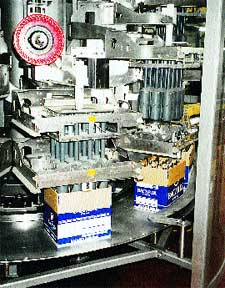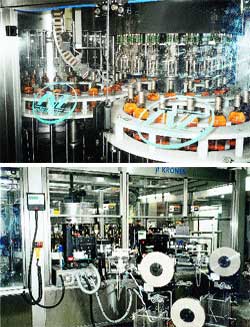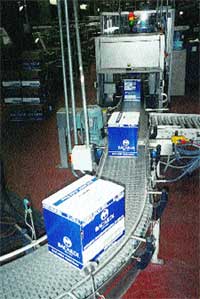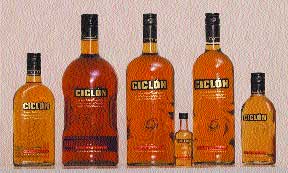Smooth bottling
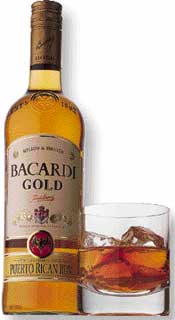
Founded in 1862 in Cuba, BACARDI has become one of the world's leading spirits producers. Its flagship rum products have been the top-selling spirit brand in the world for the past 21 years, and the Cuba Libre (Coke and rum) is now the world's leading mixed drink. The company produces approximately 20 million cases of rum annually in 11 bottling plants worldwide. This includes nine bottle sizes ranging from 50 mL to 3 L, although the 750-mL size is by far the largest seller.
One of the leaders in BACARDI's drive to dominance is its plant in Jacksonville, FL, its largest and most diversified facility. The Jacksonville plant has installed four new state-of-the-art packaging lines since 1995 to supplement older lines still in operation. This story covers the newest of these lines, which runs 750-mL and 1-L bottles of BACARDI GOLD rum.
Two-step glass manufacturing
Bottles, which are produced by Saint-Gobain Containers, are received in open-top tab-lock reshipper cases, in which the major and minor flaps of the cases are connected by a bridge (tab) of corrugated. The flaps are not glued together. Rather, when the case is manufactured, the top flaps are not separated completely. A small amount of material is left in place to hold the two flaps together while the case is assembled. When Saint-Gobain assembles the cases, the top flaps are folded down prior to the step that opens the case and glues the bottom flaps in place. BACARDI cuts the tabs after case packing.
Because the BACARDI GOLD bottle features BACARDI's bat logo embossed on the shoulder of the bottle, along with writing embossed on both the front and back, it is not a simple bottle to produce.
|
Empty bottles are removed from cases by a 10-head rotary decaser equipped with arms that descend into the cases. |
Saint-Gobain uses the latest bottle-manufacturing technology, incorporating the two-step, narrow-neck press-and-blow process to ensure the highest quality. In this process, a gob of molten glass is pressed by a plunger against the inner walls of the first mold, creating a tube-like glass parison with the correct finish on the top. The tube is then transferred to a second mold, where high-pressure air forces the glass against the mold's inner surface and into indentations that create a cartouche and writing. This is a difficult process, and temperature control is critical. Saint-Gobain maintains the temperature, which is in the range of 2,000 deg F, within ?2 deg during the second molding step. This process also produces a very uniform glass thickness throughout the entire bottle, which requires less glass, and produces a lighter, and therefore less-expensive, bottle.
Cases of empty bottles are automatically depalletized by a high-level unit from Krones. Pallets are placed on the floor-level infeed of the unit, which raises them to the discharge level. A reciprocating head equipped with vacuum cups picks up all of the cases on the top layer and moves back to deposit the cases on a discharge conveyor. This, in turn, delivers the cases, one row at a time, onto a right-angle case conveyor. A sensor detects when the cases clear the end of the depalletizer conveyor and activates the unit to deliver the next row onto the case conveyor.
At this point, the cases are traveling broadside on the conveyor and go through a station that turns them lengthwise. The cases travel around a loop to provide surge capacity for the decaser, and then descend to the main floor. Sensors at strategic points sense case backup and turn sections of the conveyor on and off as required.
Bottles are removed from the cases by a Hartness GlobalPick 10-station rotary decaser. As the cases travel around the continuous-motion machine, vertical arms equipped with grippers descend into the cases, and lift out the bottles and set them onto the takeaway conveyor.
|
Cases of empty bottles are automatically depalletized by a high-level unit, left, that removes one layer at a time with vacuum cups. Bottles are rinsed on a rotary unit, right, that inverts the bottles and rinses them with rum, which is collected, filtered and reused for rinsing until the alcohol level is depleted, at which time it is discarded. |
The patented gripper features two opposing moon-shaped plastic inserts that lock beneath a groove in the bottle's cap. An internal arm unlocks the inserts as the arm descends over the cap. The arm then releases to lock after the inserts are in place. The process is reversed to release the bottles when they are on the takeaway conveyor. A sensor on the machine detects grippers that have not descended completely and shuts off the machine.
Empty cases pass through a Heuft x-ray unit to ensure that all of the bottles have been removed and then travel up a spiral-belt conveyor from Ryson Intl. to an overhead conveyor that transports them to the bottle caser. A net is installed beneath the entire length of the conveyor to catch any cases that fall from the conveyor.
The bottles meanwhile travel initially in bulk on the conveyor through a series of converging sections until they single-file as they approach the rinser/filler/capper. At this point, two Excell printers from Videojet Technologies apply a code to the neck of each bottle. This code, which is intended for internal use by BACARDI, is covered by the cap's long skirt, so it isn't visible to the end user.
Close-coupled rinser/filler/capper
Bottles enter a tribloc combination rinser/filler/capper system supplied by Horix Mfg. The system, which operates at 400 bpm on both 750-mL and 1-L bottles, consists of a 60-head rinser, an 80-head filler and a 20-head capper, all driven by a single motor through a driveshaft and gears. The filler is manufactured by Horix, and the rinser and capper are made by Italian company Ave S.p.a. However, Horix represents Ave in the U.S. and was responsible for placing the three machines.
The machines feature synchronized bottle handling in which single starwheels transfer bottles from the rinser into the filler, and from the filler into the capper, without intervening feedscrews or conveyors. This configuration enhances bottle handling, shortens the time the product is exposed to air and reduces floorspace requirements. Another advantage is that all three machines have a common control cabinet and operator station.
Bottles entering the rinser are turned upside-down by a mechanical cam, and each rinse nozzle is opened by a pneumatic piston on receipt of a signal indicating the presence of a bottle. The bottles are rinsed with rum, which is collected, filtered and reused for rinsing until the alcohol level is depleted, at which time it is discarded. A second cam turns the bottles back upright after they drain, after which they travel through the intermediate starwheel into the filler, where a mechanical/pneumatic piston lifts the bottle under the self-centering nozzle/valve. A sensor prevents the valve from opening if no bottle is present. The nozzle seals against the top of the bottle, and product fills until it reaches the air hole in the nozzle, at which point filling stops.
BACARDI uses Horix's low-vacuum fill process, in which the vacuum is applied directly to the air hole in the filling nozzle. This draws air from the bottle before product is filled and prevents any proof losses in the product. When the product level reaches the air hole, excess product is sucked back into a recovery tank, from which it is pumped into the line delivering product to the filler bowl.
Bottles discharge through another intermediate starwheel into the rotary capper, which features a turret from Fowler Products installed by Horix on the Ave base. Roll-on pilfer-resistant caps, supplied in corrugated cases by Pechiney, are dumped into a floor hopper located at the infeed end of the packaging line near the decaser and are transported on an overhead conveyor to the capper. A rotary centrifugal sorter orients the caps and delivers them down a chute to the cap pickup point. The aluminum caps have an extra-long skirt that covers the neck of the bottle.
Caps are stripped out of the chute by bottles below on the rotating turret. An arm descends to apply pressure to the top of the cap, and four rollers revolving around the bottle force the metal into the threads in the top of the bottle, and form a lip on the side of the cap.
|
A tribloc rinser/filler/capper running 400 bpm, top, consists of a 60-head rinser, an 80-head filler and a 20-head capper. A six-head rotary labeler, bottom, has two labeling heads for each of the three labels applied to the bottles. |
As mentioned previously, one advantage of the rinser/filler/capper tribloc configuration is the single control cabinet for all three machines. This PLC-based system controls functions such as start/stop, operating speed and others simultaneously. All of the operating parameters for each bottle are included in the menu and can be selected at the touch of a button. For example, the controls will raise or lower the turrets on all of the machines in accord with the specifications in the menu. Another screen will display any faults that occur, such as a bottle backup on the filler, or an open door on one of the machines.
Bottles leaving the capper pass through a Heuft inspection system that checks for missing caps and the level in the bottles.
Labeler has redundant capabilities
BACARDI redesigned its rum packaging in '99 to emulate the high-tech imagery of the wine industry, with its alluring graphics and state-of-the-art label construction. The redesign included a new bottle and cap, but the key was the body label. Inherent in this decision was the move to pressure-sensitive labels, instead of the cold-glue labels common in the spirits industry.
BACARDI set up a project with Avery Dennison and Fleming Packaging Corp. to address these requirements. After two years of design efforts, the team settled on a design incorporating top and bottom front-body labels, one above the other, with the company's unique bat symbol bridging the gap between the two. The team first envisioned this as three separate labels, to be applied consecutively. However, it soon became evident that this could present alignment problems, so the team decided to include the bat logo at the bottom of the top label. This label would be applied after the bottom label, and the bat would overlap onto the bottom label.
A challenge for Avery Dennison was that, because the rum is such an expensive product, BACARDI removes improperly applied labels from bottles of finished product so they can be relabeled for shipment. Thus, while the labels must adhere sufficiently at application so they won't move, they also have to be easy to remove from the bottle for a short time after application without any residue remaining on the bottle. The label ultimately developed by Avery Dennison is made from 5-mil polyester film laminated to paper stock. Printing is done on the paper.
Avery Dennison manufactures the Fasson-brand pressure-sensitive label stock and ships it to Fleming, which produces the finished labels. Fleming prints the labels in six colors, plus dual foils, two varnishes and registered embossing, on a one-pass web machine that utilizes both flexographic and rotary screen printing. In addition to extremely tight registration requirements, the die-cutting is particularly tricky because of the bat logo that extends beneath the bottom of the label.
PD described the production of the new label for BACARDI GOLD rum at Fleming's plant in Orlando, FL, in our August issue (see PD, Aug., '02, p. 54).
BACARDI uses a six-station Krones Autocol labeler to apply the labels. The machine has two stations for each of the three labels, so that there will be no significant stoppage if one of the stations malfunctions or when a roll runs out. The bottom front label is applied first, followed by the top label. Lastly, the back label is applied.
Rolls of labels are mounted vertically at the three positions around the labeler. The labels are pulled into the machine, pass over a series of rollers, and are then stripped off of the backing and applied to the bottles.
The bottom face label is applied first, followed by the top label. Because the bottles are embossed front and back with BACARDI insignias, they must be precisely oriented so that the labels can be placed correctly. Contributing to the difficulty is the fact that the bat logo on the bottom of the top label, which overlaps the bottom label slightly, must be placed exactly at the top center of the bottom label. To accomplish this, the bottles have a positioning depression near the bottom, and a belt spins a bottle as it enters the labeler until a pin stops it in the exact position to receive both labels. After the top label is applied, the bottle is spun 180 deg as the machine continues to rotate until a pin stops the bottle at the correct position.
An Imaje Light Jet laser printer applies a code to the bottles just before they exit the labeler. The bottles exit the Autocol through a starwheel, and a Krones Check Mat inspection and vision system checks the bottles with two opposed cameras to ensure the presence and side-to-side placement of all three labels. If a label is missing or misplaced, the bottle is rejected.
Bottle conveyors from the decaser to the case packer were supplied by Sidel Packaging Systems Div. Sidel was also the systems integrator for all of the equipment in the packaging line. The system incorporates variable-speed drives and software from Siemens Energy & Automation, Inc. (see sidebar for details).
Case packer
In the interest of providing accumulation space, bottles leaving the labeler travel in bulk on a long conveyor past the case packer installed next to the labeler, and then loop back to enter the packer. As they enter the 10-head rotary Hartness Global Pack, the bottles go through a low-pressure infeed system that incorporates a series of switches that senses the bottle population and changes the speed of the infeed conveyors to minimize bottle backup and pressure buildup.
|
A two-part slitter/sealer combines a flap slitter that cuts tabs on the top flaps and a sealer that folds and seals the flaps. |
Bottles move from the first conveyor, which is about 4 ft wide, into three lanes that start out about three bottles wide. This combination of wide conveyors and lanes operates at very low speeds compared to one-bottle-wide systems, and contributes to the low-pressure operation. The lanes gradually converge into one-bottle-wide conveyors, at which point the bottles travel across a deadplate onto higher-speed chains that carry them to the pickup point. These chains fill in any voids in the line of bottles to ensure that there are always bottles present for pickup.
Empty cases are delivered to plates mounted on the lower level of the machine that line up with the loading stations mounted above them. The system essentially reverses the unpacking procedure described previously, utilizing the same kind of grippers. Bottles are separated into groups of 12 and, as the continuous machine rotates, the grippers descend and pick up the bottles, then lower them into the cases. Plastic fingers descend into the cases ahead of the bottles to ensure that the partitions are placed correctly and to direct the bottles into the cases. They also help prevent label scuffing by keeping the bottles from contacting the partition walls.
A sensor at the case infeed detects if a case arrives with a bottle in it and stops the machine. Other sensors are installed to make sure that there are enough cases on the infeed conveyor, that a case is in position prior to loading, and that a bottle is not sticking out of the top of the case after it leaves the loading station.
Filled cases discharge onto a conveyor that transports them to a slitter/sealer from Pearson Packaging Systems. This two-part system combines a Model U2100 flap slitter that cuts the tabs on the top flaps with a Model N401 top sealer, which folds and then seals the flaps. The machine incorporates a Nordson Series 3500V hot-melt glue system running Technomelt glue from Henkel Adhesive Corp.
More information is available:
Bottles: Saint-Gobain Containers, 765/741-7000. Circle No. 201.
Depalletizer, labeler, label inspection: Krones, Inc., 414/409-4000. Circle No. 209.
Decaser, caser: Hartness Intl., Inc., 964/297-1200. Circle No. 210.
Spiral case conveyors: Ryson Intl., 757/888-2766. Circle No. 211.
Printer: Videojet Technologies, 800/654-4663. Circle No. 212.
Filler, rinser and capper representative: Horix Manufacturing Co., 412/771-1111. Circle No. 213.
Capper turret: Fowler Products Co., 706/549-3300. Circle No. 214.
Inspection systems: Heuft USA, Inc., 636/230-8482. Circle No. 216.
Label stock: Avery Dennison, 440/639-3000. Circle No. 217.
Labels: Fleming Packaging Corp., 407/497-8443. Circle No. 218.
Laser printer: Imaje USA, 678/296-2202. Circle No. 219.
Bottle conveyors, integrator: Sidel Packaging Systems Div., 941/727-1400. Circle No. 220.
Variable frequency drives, software: Siemens Energy & Automation, Inc., 770/740-3000. Circle No. 221.
Slitter/sealer: Pearson Packaging Systems, 509/838-6226. Circle No. 222.
Hot-melt glue system: Nordson Corp., 770/497-3715. Circle No. 223.
Hot-melt glue: Henkel Adhesive Corp., 847/468-9200. Circle No. 224.
Caps: Pechiney, 450/469-0777. Circle No. 203.
High-profile packaging |
Packaging is making a big impact at BACARDI. Two of its innovative products captured The Glass Packaging Institute's 2002 Clear Choice Awards in the Distilled Spirits Category, and an incredible new bottle is making its debut on store shelves. |
System integration |
Sidel Packaging Systems Div. (formerly Gebo Corp. USA) has been involved in the systems integration of the four new packaging lines at BACARDI's Jacksonville, FL, plant since BACARDI began planning the new lines in '96. Sidel designed, engineered, programmed and carried out both the installation and startup supervision of each line. The detailed mechanical and electrical engineering phases encompassed all equipment specifications, requests for quotes, equipment evaluation and recommendations to BACARDI. BACARDI subsequently issued each purchase order against the purchasing document written by the Sidel project manager for each machine. |
About the Author(s)
You May Also Like
